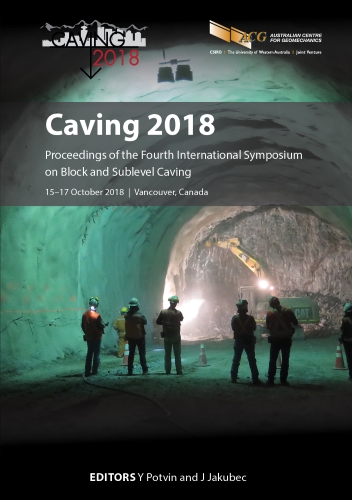Chuquicamata underground mine design: the simplification of the ore handling system of Lift 1

|
Authors: Paredes, P; Leano, T; Jauriat, L |
DOI https://doi.org/10.36487/ACG_rep/1815_27_Paredes
Cite As:
Paredes, P, Leano, T & Jauriat, L 2018, 'Chuquicamata underground mine design: the simplification of the ore handling system of Lift 1', in Y Potvin & J Jakubec (eds), Caving 2018: Proceedings of the Fourth International Symposium on Block and Sublevel Caving, Australian Centre for Geomechanics, Perth, pp. 385-398, https://doi.org/10.36487/ACG_rep/1815_27_Paredes
Abstract:
The ore handling system layout plays a fundamental role in cave mining projects, not only because it is one of the main drivers in the production capacity and reliability of the mining system, but also because it is a fundamental variable in the footprint’s development time and cost (Paredes et al. 2016). In terms of ore handling system definition, the governing paradigm in Codelco’s projects has been the productivity maximisation through the optimisation of load–haul–dump unit (LHD) tramming distances. This has resulted in layout designs that solve the productive-effectiveness problem by shortening the LHD tramming distance by introducing orepasses inside the footprint area. Following this principle, the original macro block design of the Chuquicamata Underground Mine Project (PMCHS) considered an ore handling system layout based on the maximisation of operational flexibility. In this design, LHDs dumped into orepasses located inside the footprint area, transferring the ore into crusher chambers located below the production level, where ore was crushed and then conveyed to surface. This resulted in a very flexible layout for the operation, but at the same time, implied the execution of a large amount of vertical and major infrastructure excavations, as well as the assembling, commissioning and operation of a large amount of mechanical equipment for the mine. The caving industry today has proven the effectiveness of simpler layouts based on direct tipping by LHDs to crushers positioned in the periphery of the footprint. The productivity competitiveness of these type of layouts is based on the use of intensive preconditioning and larger LHD and crushing equipment (Manca 2013; Flores 2014; Paredes et al. 2016). A first approach in improving Chuquicamata’s mine design with a simpler mine layout was performed in 2015 (Paredes et al. 2016), but for a limited experimental area. Then, during 2017, in order to improve the whole project’s economics by reducing development time and cost (with a simpler mine design), and in parallel with the development of the initial macro blocks, the PMCHS ore handling system for Lift 1 was reengineered, aiming to capture the latest improvements in existing technology, such as the application of large-scale rock mass engineering, with higher capacity loaders and crushers able to process larger sized boulders tipped directly from large bucket loaders. This paper presents the main considerations and results for the transition from a traditional LHD–orepass layout to a LHD–peripheral crusher-based layout.
Keywords: mine design, ore handling system, block caving, caving projects
References:
Araneda, O 2015, ‘Challenges and opportunities in open pit to underground transition at the Chuquicamata underground mine project’, Proceedings of the 4th International Seminar on Mine Planning, Gecamin, Santiago.
Brunton, I, Sharrock, G & Lett, J 2012, ‘Full scale near field flow behaviour at the Ridgeway Deeps Block Cave operation’, Proceedings of MassMin 2012, Canadian Institute of Mining, Metallurgy and Petroleum, Westmount.
Callahan, M, Keskimaki, K & Rech, W 2000, ‘A case history of the crusher level development at Henderson’, Proceedings of MassMin 2000, The Australasian Institute of Mining and Metallurgy, Melbourne, pp. 307–316.
Catalán, A, Onederra, I & Chitombo, G 2012, ‘A proposed methodology for evaluation of the preconditioning by blasting at the Cadia East panel cave mine’, Proceedings of MassMin 2012, Canadian Institute of Mining, Metallurgy and Petroleum, Westmount.
Chacón, J, Göpfert, H & Ovalle, A 2004, ‘Thirty years of block caving evolution in Chile’, in A Karzulovic & MA Alfaro (eds), Proceedings of MassMin 2004, Instituto de Ingenieros de Chile, Santiago.
Cook, B, Burger, D, Alberts, L & Glober, R 2008, ‘Automated loading and hauling experiences at De Beers Finsch Mine’, Proceedings of the Tenth Underground Operator’s Conference, The Australasian Institute of Mining and Metallurgy, Melbourne.
Flores, G 2014, ‘Future challenges and why cave mining must change’, in R Castro (ed.), Proceedings of the Third International Symposium on Block and Sublevel Caving, Universidad de Chile, Santiago, pp. 23–52.
Fuentes, S & Villegas, F 2014, ‘Block caving using macro blocks’, in R Castro (ed.), Proceedings of the Third International Symposium on Block and Sublevel Caving, Universidad de Chile, Santiago, pp. 211–216.
Manca, L 2013, ‘Modern planning practices for cave mining’, in J Beniscelli, H Göpfert, E Henríquez, H Constanzo, C Bottinelli & J Cárdenas (eds), Proceedings of the Third International Seminar on Mine Planning, Gecamin, Santiago.
Marsh, D, Pepplin, C & Ross, I 2010, ‘Design optimization of Grasberg Block Cave haulage’, Proceedings of the 2010 SME Annual Meeting, Society for Mining Metallurgy & Exploration, Englewood.
Masse, S, Prince, F & Keskimaki, K 2014, ‘New Afton Mine: The world’s newest block cave mine’, Mining Engineering Magazine, vol. 66, no. 1.
Molina, R, Cerruti, C, Henriquez, J, Morales, R & Apablaza, R 2008, ‘Preconditioning implementation on rock bulks in Codelco Chile and its results’, in H Schunnesson & E Nordlund (eds), Proceedings of MassMin 2008, Luleå University of Technology, Luleå.
Osorio, F, Espinoza, A & Cerrutti, C 2007, Guía preliminar de planificación, diseño y operación del preacondicionamiento, Gerencia Corporativa Proyecto Minería Subterránea Codelco, internal report, Codelco, Santiago, in Spanish.
Paredes, P, Gajardo, D, Leaño, T, Peñaloza, S & Tramón, C 2016, ‘Simplifying the ore handling system through the use of current technology at Chuquicamata underground mine project’, Proceedings of MassMin 2016, The Australasian Institute of Mining and Metallurgy, Melbourne, pp. 571–584.
ProModel Corporation 2018, ProModel, computer software, ProModel Corporation, Allentown, https://www.promodel.com/
© Copyright 2025, Australian Centre for Geomechanics (ACG), The University of Western Australia. All rights reserved.
View copyright/legal information
Please direct any queries or error reports to repository-acg@uwa.edu.au
View copyright/legal information
Please direct any queries or error reports to repository-acg@uwa.edu.au
